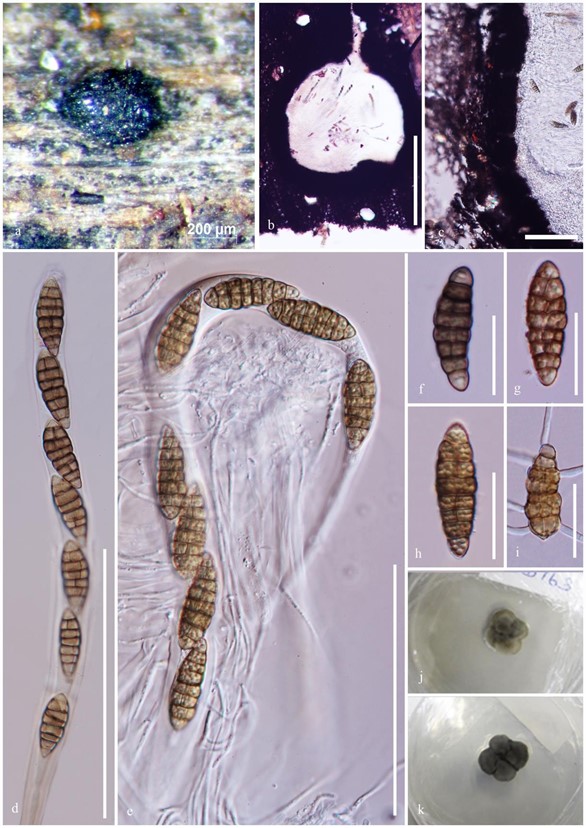Halotestudina muriformis Dayarathne & K.D. Hyde, sp. nov. Fig. 38
MycoBank number: MB 556583; Index Fungorum number: IF 556583; Facesoffungi number: FoF 06171;
Holotype – MFLU 17-2634
Saprobic on mangrove wood. Sexual morph: Ascomata 750–990 × 700–750 µm (x̅ = 880 × 740 μm, n = 5), globose to subglobose, semi immersed, carbonaceous to coriaceous, black, gregarious, ostiolate. Peridium 70–90 μm wide, coriaceous to carbonaceous, two-layered, outer layer composed of elongate cells, inner layer composed of smaller hyaline cells. Hamathecium comprising 0.6–1.5 μm wide, hyaline, branched, aseptate, pseudoparaphyses, anastomosing above the asci, embedded in a gelatinous matrix. Asci 180–240 × 15–27 μm (x̅ = 200 × 22 μm, n = 20), 8- spored, bitunicate, fissitunicate, cylindrical, short-pedicellate, with a non-amyloid, apical ring. Ascospores 30–45 × 10–17 μm (x̅ = 34 × 12 μm, n = 20), uniseriate, ellipsoidal to broadly fusiform, muriform, with 7 transverse septa and 0–2 longitudinal septa, brown, with pale brown apical cells, constricted at the septa, smooth-walled. Asexual morph: Unknown
Material examined: – THAILAND, Krabi Province, Krabi, on decaying wood of Rhizophora sp. (Rhizophoraceae) wood, 31 August 2017, M.C. Dayarathne, MCD 163 (MFLU 17-2634, holotype), ex type living culture MFLUCC 18-0392; THAILAND, Phetchaburi Province, Cha-am beach, on bark attached to the living plant of Bruguiera sp. (Rhizophoraceae), 06 December 2016, M.C. Dayarathne, MCD 035 (MFLU 18-0524), living culture MFLUCC 17-0395.
GenBank numbers: – LSU: MN017852, MN017894, MN017853, MN017854; SSU: MN017918, MN017947, MN017919, MN017920; TEF: MN077068: RPB2: MN077079
Notes: – Halotestudina muriformis is characterized by globose to subglobose, semi immersed, carbonaceous to coriaceous ascomata, branched, aseptate, pseudoparaphyses, anastomosing above the asci and ellipsoidal to broadly fusiform, brown, muriform ascospores with 7 transverse septa and 0–2 longitudinal septa, with pale brown apical cells, constricted at the septa. Four isolates of H. muriformis formed a moderately supported (73% ML) clade within Testudianace sister to Angustospora nilensis (MFLU 15-1511) and Trematosphaeria wegeliniana (CBS 123124) (Fig. 37). Morphologically, genera of Testudinaceae are highly diverse especially by having different ascospore morphologies and this is the first record of brown muriform ascospores in Testudinaceae. TEF and RPB2 base pair differences of Halotestudina muriformis to Muritestudina chiangraiensis and Verruculina enalia are given in Table 6.

Figure 38 – Halotestudina muriformis (MFLU 17-2634, holotype). a Ascoma on host surface. b Section of ascoma. c Peridium. d, e Asci and pseudoparaphyses. f–h Immature and mature ascospores. s Germinating ascospore. n, o Cultures on sea water PDA (n-upper, o lower). Scale bars: a, b = 200 μm, d, e = 100 μm, c = 50 μm, f–i = 20 μm.
Table 6 Base pair differences of Halotestudina muriformis and related taxa.
| Taxon | LSU | TEF | RPB2 |
| Muritestudina | 6.8% (60 bp out of | 26% (136 bp out of | 21% (202 bp out of |
| chiangraiensis | 874 bp) | 515 bp) | 1011 bp) |
| Verruculina enalia | 7.2% (63 bp out of
874 bp) |
111.3% (103 bp out
of 912) |
19.6% (156 bp out of
792 bp) |
